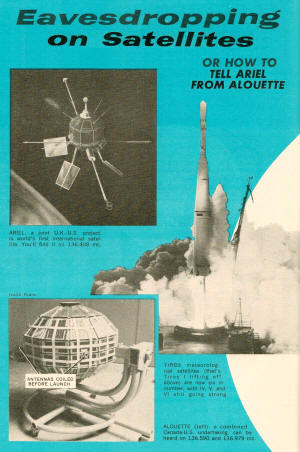Eavesdropping on Satellites
|
|
February 1963 Popular Electronics  Table of Contents Table of Contents
Wax nostalgic about and learn from the history of early electronics. See articles from Popular Electronics, published October 1954 - April 1985. All copyrights are hereby acknowledged. 1963 was five years since America's first communications satellite, Echo, was placed in orbit. Echo was a passive, spherical reflector that merely provided a good reflective surface for bouncing radio signals off of. By 1963, the space race was well underway and active communications satellites were being launched at a rapid pace. This 1963 issue of Popular Electronics magazine reports on satellite signals being received by other than their intended targets. Spotting and tracking satellites has long been a popular pastime with two types of hobbyists: amateur astronomers using telescopes and binoculars, and amateur radio operators using antennas and receivers. Today's amateurs are picking up signals from spacecraft orbiting Mars (NASA's Mars Reconnaissance Orbiter in 2018, and China's Tianwen-1 probe in 2021) and are finding long-lost and presumed-dead (aka "zombie") Earth-orbiting satellites (NASA's IMAGE in 2020, and Cold War era military LES-5 in 2020). Eavesdropping on Satellites By Tom Lamb, K8ERB
Fortunately, too, a large and elaborate antenna system is NOT necessary at these frequencies. In fact, near overhead passes can be picked up with a 3' 7" dipole, and you may even get satisfactory results with a TV antenna. Start by listening for the Tiros satellites, since their signals are moderately strong. With your antenna pointed SE or SW (in the U.S.), set your receiver for c.w. reception, use a medium i.f. selectivity, and tune to 136.230 mc. If your converter and receiver calibration aren't spot on, tune around the satellite's frequency every five minutes or so, listening carefully for a weak carrier. An accurate receiver can be left on the frequency until the carrier appears, although it could take up to 12 hours for you to hear the first pass. A single, low-orbit satellite can be heard for up to seven successive passes, followed by a 12-hour quiet period; the exact sequence will depend to some extent on your location and system sensitivity. Once you pick up the carrier, change to a narrow i.f., use a Q-multiplier, or try any of the other tricks you may have for receiving very weak signals. Identifying Satellites. All NASA satellites transmit a carrier (beacon) for tracking purposes, and it's relatively easy to tell when you've picked one up: (1) It will be accurately on frequency, but- (2) A satellite will appear to be slightly high in frequency when approaching, slightly low when receding. This Doppler effect will vary from nearly zero for a distant pass to about 7 kc. for an over-head pass, and it's one sure way to identify a satellite. (3) Low-orbit (750-mile or so) satellites will be heard for only about 18 minutes during each pass-usually considerably less. (4) A satellite will usually be heard for several successive passes. (Since both Tiros V and Tiros VI are on the same frequency, they confuse the picture somewhat-but their transmissions will still be separated by the orbit period.) (5) Most satellites are modulated by telemetry equipment. This modulation may be quite weak, and audible only on near overhead passes. Now that you know how and where to listen, you'll also want to know what satellites to listen for. There are at least six, as we mentioned, of which the Tiros group are especially good bets. Here they are, listed in order of ascending frequency. Telstar. Frequency, 136.050 mc.; period, 157.7 minutes; altitude, 590-3500 miles. Telemetry on several very weak subcarriers. Long period and high altitude make Telstar difficult to catch . Tiros IV, V, VI. Frequencies, (IV) 136.230 and 136.920 mc., (V and VI) 136.235 and 136.922 mc.; period, (IV and V) 100.5 minutes, (VI) 98.7 minutes; altitude, 420-520 miles. Telemetry on weak subcarriers 1 kc. above and below carrier. Tiros satellites are moderately strong and pass frequently. Weather map pictures are transmitted on a higher band. Ariel. Frequency, 136.408 mc.; period, 100.8 minutes; altitude, 247-750 miles. Telemetry sounds like clanking chains, out to ±15 kc. Ariel's modulation is keyed from the ground and is not always present. Ariel is believed to have suffered major solar cell damage from radiation belts and is transmitting erratically. Alouette. Frequencies, 136.590 and 136.979 mc.; period, 105.5 minutes; altitude, 600 miles. Telemetry on multitone subcarriers out to ±20 kc. A wide assortment of beeps and clanks makes Alouette one of the most interesting satellites to log. Other satellites in the NASA band are probably commanded from the ground and are very elusive. But get Alouette, Ariel, Telstar, and Tiros (IV, V, and VI!) in your log before you start thinking about snatching any of the hard ones!
Posted March 31, 2021 |
